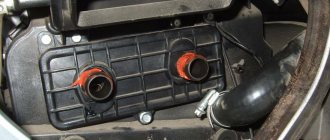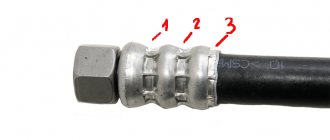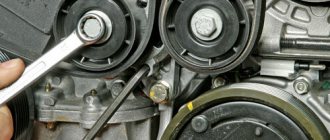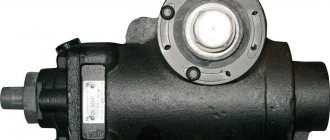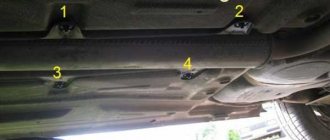Signs of malfunctions in the power steering system
There are several signs that the power steering system is airy, in which case it is necessary to bleed it. Among them:
- the appearance of strong noise in the area where the power steering or its pump is installed;
- increased pressure on the steering wheel , difficulty turning it;
- leakage of working fluid from the power steering system.
In addition, there are several other signs that indicate the system is becoming airy - the appearance of foam on the surface of the working fluid in the expansion tank, spontaneous turns of the steering wheel to one side. If you encounter at least one of the described symptoms, it means you need to bleed your power steering.
Preparatory stage
If the following symptoms occur during operation of the power steering on a ZIL, begin the pumping process:
- The steering wheel mechanism experiences increased pressure and turns hard. It becomes difficult to make turning movements.
- Formation of non-standard noise interference. The pumping mechanism starts with a roar or such signs appear at the State Unitary Enterprise.
- Still usable fluid flows out of the hydraulics.
- Uncontrolled movements of the steering mechanism. Malfunction of the spool mechanism due to clogging of the existing channels or an error during assembly.
- Formation of foam composition inside the expansion tank (on top of the composition). In this case, it is possible that the products have been mixed or the pumping mechanism has malfunctioned.
If any of the listed signs appear, you should begin the procedure of pumping the power steering on the ZIL-130. It is from this origin that leads to the logical question of how to pump up the power steering on a ZIL-130.
Is it worth doing this work on your own? It depends on the desire, skills of the particular vehicle owner, as well as the need to save. The cost of the liquid is affected by parameters. For pumping you will need 1-3 liters.
How to pump power steering
How to fill oil and bleed power steering
The procedure for replacing fluid and pumping power steering is carried out in strict accordance with the existing algorithm. Some automakers may add their own features to it. If you have a manual for your car, we recommend that you read the relevant section. In general terms, the steps must be performed in the following sequence:
- Raise the vehicle completely on a lift or with the front wheels off the ground.
- If necessary, drain the old fluid from the expansion tank. To do this, remove the return hose (going to the power steering system) from the expansion tank and put a plug on it so that liquid does not spill out of the hose. A hose leading to an empty bottle is connected to the released tap on the tank, where the old hydraulic fluid is supposed to be drained.
- It is most convenient to pump out the main volume of liquid with a syringe and pour it into a separate bottle. When there is very little liquid left, move on to the next point.
- Fill the expansion tank with working fluid to the top.
- Next, you should turn the steering wheel from side to side (from lock to lock) several times so that the old fluid remaining in the system flows out through the hose. Since the new fluid displaces the old, do not forget to monitor the oil level in the tank so that air does not get into the hose.
- If the fluid level drops, add it again.
- Start the engine for 2-3 seconds and turn it off. This is done so that the liquid begins to spread throughout the system.
- Next, add working fluid to the tank to the MAX level and repeat the procedure by starting the engine. Repeat this cycle 3-5 times.
- The signal to stop pumping is the fact that air from the return hose stops entering the drain bottle. This means that there is no more air left in the hydraulic system and fresh, clean fluid enters the reservoir.
- After this, you need to reinstall the return hose (connect it to the expansion tank where it was originally installed).
- Refill the reservoir to the MAX level, then start the engine.
- To pump the hydraulic booster, you need to slowly turn the steering wheel 4-5 times from the left to the right stop. At the stop points, pause for 2-3 seconds. If there is any air left, it should escape into the expansion tank. During the inspection process, we make sure that the pump does not make any extraneous noise.
- An indicator that pumping has ended will be the absence of air bubbles on the surface of the liquid in the tank.
- After this, close the expansion tank tightly.
Basic information about the hydraulic booster
Power steering or, as it is abbreviated as power steering, is a vehicle’s hydraulic system, part of the steering mechanism, which is designed to facilitate the direction of movement of the vehicle while maintaining the necessary feedback, as well as ensuring stability of operation and unambiguity of the specified trajectory. In addition, the power steering is designed in such a way that if it fails, the steering wheel will function, but in this case the steering wheel will turn a little harder. Power steering is one of the most important steering components of any vehicle. The main purpose of power steering is to create lateral forces when turning the steering wheel due to the presence of an electric drive. Almost all modern vehicles are equipped with power steering.
Experienced motorists highlight several main advantages of power steering on Gazelle cars, such as:
- High level of reliability;
- High information content;
- Low fuel costs;
- Convenience of adjusting the technical characteristics of the manual.
The main disadvantages of power steering for Gazelle cars include:
- High cost;
- Difficulty in establishing;
- Significant changes to the steering system of the vehicle;
- Needs regular maintenance.
How does power steering work for Gazelle cars?
- Pump. Thanks to this device, circulation of working fluid and pressure is ensured.
- Steering gearbox with distributor. With its help, an air flow is provided that directs the oil into the required cavity of the cylinder or back into the tank.
- Cylinder. With the help of a cylinder, fluid pressure is converted into movement of the piston and rod.
- Oil that transmits force from the pump to the cylinder and also lubricates all friction pairs.
How is power steering fluid replaced?
Power steering oil needs to be changed periodically, and the frequency of change depends on the condition of the steering wheel, the characteristics of the fluid, and the brand of the steering wheel. That is, when the steering wheel is difficult to turn or noise is heard when turning, you need to add a little or completely replace the power steering fluid. It is necessary to replace the fluid in the power steering almost every sixty thousand kilometers; this is, so to speak, a partial repair of the power steering. So, how to replace the fluid in the power steering on a Gazelle car?
- Place the car on a jack or inspection hole;
- Hang up the front car wheels;
- Disconnect the return hose;
- Drain the power steering fluid from the power steering reservoir;
- Remove and wash the tank containing the working fluid;
- Install the tank but do not attach the return hose;
- Start the engine and turn the steering wheel all the way to idle speed;
- Completely drain the system;
- Turn off the engine;
- Fill the tank with suitable liquid;
- Start the engine and increase the speed to a thousand revolutions per minute;
- After fluid begins to flow from the return hose, turn off the car engine;
- Repeat the previous steps a couple of times until all air has been removed from the amplifier system;
- Connect the return hose to the tank;
- Add fluid to the required level;
- Start the car engine and at a speed of approximately one thousand revolutions per minute, turn the steering wheel until it stops several times;
- Check the foaming liquid for foaming. If the liquid foams, continue pumping.
- Stop the engine and check the fluid level in relation to the functioning amplifier;
- Set the fluid level in the amplifier to the appropriate level;
- After some time, check the air amplifier, as well as the fluid level;
- The fluid replacement is complete, all that remains is to put everything back together in reverse order.
Repairing the pump
Due to active use and heavy loads, it is often necessary to repair the power steering pump. The difficulty of carrying out repairs lies only in the fact that the power steering pump for a Gazelle car cannot be disassembled, which means that it does not have any covers or locking rings, but repairing the pump is still possible. First you need to remove and disassemble the power steering pump according to the instructions that come with the kit. After this, you need to thoroughly clean it from dirt and dust, and also inspect it to determine the cause of the breakdown. The cause of the breakdown may be wear of the oil seal, in which case it needs to be replaced. When installing the oil seal, it may be necessary to modify the shaft.
There are several methods to secure a new bearing in the pump structure. You can make a recess on the outside of the bearing, drill threaded holes in the pump wall, install a new bearing and secure it with sharpened bolts. Alternatively, you can secure the bearing in the middle of the power steering pump using the folded edges of the housing. After the repair is completed, you need to reassemble the power steering pump in the reverse order. Please note that after repairs, new parts may create some noise, but this is just the grinding in of new parts. After repairs, be sure to replace the power steering fluid.
Typical power steering malfunctions
Malfunctions in the operation of the hydraulic booster can be easily identified by characteristic signs. Among them:
- The steering wheel turns hard . Probable causes are failure of the power steering pump, use of unsuitable working fluid, sticking of the spool mechanism channels.
- , a high-frequency sound (similar to a whistle) is heard while driving The probable cause is a loose drive belt.
- The steering wheel turns jerkily . Probable causes of the malfunction are the working fluid not meeting the specifications declared by the manufacturer, a malfunction of the fluid distributing mechanism, or a pump malfunction.
- The presence of intense foaming in the expansion tank. Probable causes are mixing of different types of fluids, failure of the power steering pump.
- When the engine is running, the steering wheel spontaneously turns in any direction . The probable cause is malfunction of the spool mechanism, most often, clogging of its working channels, incorrect assembly (for example, after installing a repair kit).
Recommendations for operation and maintenance of power steering
In order for the power steering and its system to operate normally, as well as to extend their service life, you must adhere to several simple rules:
- use working fluids recommended by the automaker , and also replace them in a timely manner (most automakers recommend replacing power steering fluid every 60.120 thousand kilometers, or once every 2 years, it depends on the driving style and intensity of use of the car);
- carry out bleeding of the power steering system in strict accordance with the algorithm described above (or observing individual requirements, if any are set by the car manufacturer);
- monitor the condition of the steering rack boot , because if it is torn, dust and dirt will enter the system, which leads to the power steering pump exiting. A sign of a problem that has already occurred is the hum of the power steering, which is not eliminated even by replacing the fluid.
Cost of replacing fluid and pumping power steering
If you plan to carry out work on replacing the fluid and pumping the power steering yourself, then you will only need to buy oil in a volume of 1 to 3 liters (including flushing, while the volume of the power steering system of a passenger car is up to 1 liter). The price of the liquid depends on the brand and store. It is within $4.15 per liter. If you do not want or cannot carry out such work yourself, contact a service station for help. Approximate prices for January 2022 are:
- fluid replacement work - 1200 rubles;
- power steering pumping - 600 rubles.
What types of power steering fluids are there?
Based on the foregoing, it can be understood that all elements of the system only provide fluid pressure, give the desired direction to the parts and convert pressure into force. The main working element in the power steering system is liquid.
Power steering fluid, no matter who makes it, is based on petroleum components. Essentially this is the same oil, only with certain properties.
If motor oils have the main task of lubricating rubbing parts, then power steering oil has the task of transmitting force.
And since it must be quickly transmitted through the channels, the power steering fluid should not be very viscous, but at the same time this oil should also lubricate the system elements, but to a slightly lesser extent than engine oil.
Power steering fluids are available in two types:
- Mineral;
- Synthetic.
Mineral is used in most power steering, synthetic is less common.
A feature of these liquids is not interchangeability, as is the case with motor oils. In this case, switching from mineral fluid to synthetic fluid will lead to power steering failure.
And all because synthetic fluids contain additives that negatively affect the service life of rubber-based rubber elements, but there are enough such elements in power steering.
Ford synthetic power steering fluid “DP-PS”, 1 l.
Usually in those The vehicle documentation indicates that synthetic power steering fluid is used, and only that should be used.
If there is no information on the fluid in the documentation, then the car uses mineral by default.
Power steering oil requirements
- Heat resistance.
Since the oil is intended not only for lubricating mechanisms, it acts as a heat sink from heated parts and parts of the hydraulic booster. The liquid must be resistant to high temperatures up to 110⁰C, and also not lose its properties at low pressure and at temperatures down to minus 35⁰C.
- Stable viscosity.
Power steering oil contains additives that control the level of fluid viscosity under conditions of changing ambient temperatures. Thanks to this, at low temperatures the oil retains its properties and does not thicken, which allows you to rotate the steering wheel without extra effort.
- Transparency and homogeneity.
A distinctive property of good and high-quality oil is its transparent appearance and uniform consistency. Even after the machine has been idle for a long time, additives should not precipitate and clog the oil.
- Wear resistance.
Oil still has an aggressive effect on the rubber parts and mechanisms of the machine. It is worth choosing a type of fluid that has special additives with the function of a protective film, thereby reducing the wear life of rubber parts.
- Slight foaming.
An undesirable phenomenon in the power steering oil tank is foaming. The appearance of bubbles can have a bad effect on the steering wheel turning mechanism, namely, the process of transferring force from the steering wheel to the turning mechanism will be difficult. So you should pay attention to this important criterion when choosing oil.
Color characteristics of liquids
Also, power steering fluids are divided among themselves by color. Interestingly, initially they were all red - Dexron.
According to their class, power steering fluids are classified as automatic transmission fluids (ASF), but power steering fluids have a different designation PSF
.
At the same time, PSF is the same as ASF, but only the latter’s additives are slightly different, and are designed to work with gearbox clutches, which power steering does not have.
But these additives do not in any way affect the operation of the power steering, so Japanese cars often come from the factory with ASF poured into the power steering reservoir.
Bleeding the power steering system
We pump the power steering system when air gets into the system during repair work related to depressurization of the system.
If there is air in the system, the steering becomes jammed when trying to make a sharp turn.
Also, the power steering pump makes increased noise when the steering wheel is turned, and the fluid in the reservoir foams.
Pour working fluid into the power steering system
Apply the handbrake and place chocks under the rear wheels of the car.
Raise the front of the car.
Set the steering wheel to a straight position and start the engine.
Turn the steering wheel to the right until it stops. Air bubbles should appear in the tank.
Turn the steering wheel to the left until it stops. If there is air left in the hydraulic system, air bubbles should appear in the reservoir.
Check and, if necessary, add fluid to the maximum mark.
We continue pumping until the working fluid enters the tank without air bubbles.
We install the car on the wheels and check the operation of the system.
Source of the article: https://avtomechanic.ru/gazel/tekhobsluzhivanie-gazeli/proverka-i-prokachka-sistemy-gidrousilitelya-rulya-avtomobilya-gazel
Lots of details
Power steering is a whole complex of individual units and elements such as:
- Power steering pump
- Steering rack combined with a hydraulic cylinder (there are rack models with an external hydraulic cylinder)
- Working fluid control device (spool mechanism)
- High and low pressure connecting hoses
- Expansion barrel
- Working fluid
The pump is a metal casing, inside of which a drum with blades rotates. As the blades rotate, they capture the working fluid and supply it under pressure to the steering rack. The pump is driven by an engine via a belt drive. In electric boosters, the pump rotates using an electric motor.
The steering rack is made in the form of a cylinder, inside of which there is a gear rack, which is also a hydraulic cylinder rod, a hydraulic cylinder piston and a control mechanism. Steering rods are screwed into the ends of the rack, which are connected to the rotary hub. The steering rod is movably connected to a gear rack through cardan joints. The spool mechanism is a pressure distributor of the working fluid in the cylinder cavity, depending on the rotation of the steering wheel. It is redirected through channels to the power steering piston, or in the “straight” position, it simply circulates around the ring without doing any work.
The expansion tank is located above the pump level in the engine compartment. It is usually made of durable plastic. Inside it has a filter element and a liquid pressure divider.
Special oils of a certain viscosity and operating temperature are used as the working fluid of the power steering. Usually the manufacturer indicates the specification of power steering oil, but for the average person they also indicate its color, which coincides with the color of the expansion tank cap. For example, the Volkswagen concern uses green. Filling liquids of different specifications is unacceptable; we’ll talk about what this will lead to below.
pumping power steering (can be found in the FAQ
During operation, the hydraulic system is pumped to remove air from the hydraulic system after eliminating faults that led to a leak, and after replacing the tank or oil.
The presence of air in the hydraulic system is characterized by the effect of “wedging” the steering wheel when there is a sharp change in the direction of its rotation, an abrupt change in the force on the steering wheel when turning to the right, cloudy oil and the presence of oil in the tank, as well as increased noise of the hydraulic system.
It is recommended to bleed the hydraulic system with the front wheels hanging.
Before pumping you need to:
— clean the bleeding valve located on the top cover of the steering mechanism from dirt and dust and remove the rubber cap;
— place a transparent plastic tube with an internal diameter of 6.5 mm onto the bleeding valve and immerse the free end of the tube into the oil tank until it touches the filter element.
Bleeding procedure (carried out with the engine not running):
— turn the steering wheel to the extreme left position all the way;
- unscrew the bleeding valve 1/3 - 1/2 turn;
— turn the steering wheel to the extreme right position all the way and, holding it in this position, close the bleeder valve;
- continue performing these four operations in the given sequence until oil flows through the tube without air bubbles;
— after pumping is complete, close the valve and remove the tube;
How to check, fill and bleed the Gazelle power steering system
Checking the level and adding fluid to the power steering reservoir
The reservoir is located on the left side of the engine compartment, next to the washer fluid reservoir.
Check the fluid level in the power steering pump reservoir.
It should be between the “MAX” and “MIN” marks marked on the tank body.
If the level is significantly lower, add fluid.
2. To do this, unscrew the tank cap.
3. Add working fluid to the required level
Advantages and disadvantages of the system
As a rule, complex equipment has both pros and cons. The ZIL-130 power steering was no exception. Advantages:
- softened shocks, impacts from wheels;
- reducing the number of steering turns required when turning;
- easier steering turn.
Flaws:
- High fuel consumption. Each additional element started from the engine will consume additional fuel.
- Reducing the power of the device due to the presence of a working pumping mechanism.
- Power steering cannot be controlled electronically (economy options).
Replacing power steering fluid
In the power steering system, the fluid must be replaced when it becomes dirty, and after 6 years of vehicle operation.
1. Hold the nut from turning and unscrew the pressure hose going to the steering mechanism.
2. Drain the fluid from the power steering system. Without starting the engine, turn the steering wheel in both directions from lock to lock until fluid stops flowing out of the hose.
We reconnect the hose to the pump and tighten the fitting to a torque of 44 - 62 Nm (4.4 - 6.2 kgcm).
3. Fill the system with fresh working fluid.
4. Start the engine. In this case, liquid will flow into the system.
Add fluid with the engine running until the level remains constant.
5. Bleed the power steering system.
The need for an oil change
During operation of the hydraulic booster, the fluid decreases. Therefore, the necessary pressure is not provided, making driving difficult. In addition, the liquid may:
- the physical indicator changes at elevated temperatures;
- pollution occurs.
Therefore, the recommended replacement is made every 10-20 thousand kilometers or after 2-3 years.
A complete replacement will require 2-3 liters of oil, which expands when heated, so you need to leave some space free. To do this, 2 measurements are taken: hot, cold.


